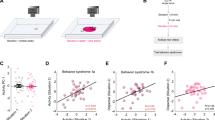Abstract
NormalDrosophila melanogaster males rapidly react to changes in the mobility of mutantshibire ts females by performing less courtship when the females are paralyzed and by courting movingshibire ts females vigorously. Mutantoptomotor-blind males, which are unable to respond to certain horizontally moving patterns, sustain abnormally short courtship bouts when tested with normal females, almost never perform orientation, one of the courtship behaviors, and require more time to initiate copulation than normal males. These results suggest that males must perceive female movement to perform normal courtship and copulation. Normal females become stationary before copulation occurs. Normal males mate quickly in response to this change in female behavior, while blind males require more time to effect copulation, prolonging the time that the female remains stationary. Mutantsmellblind females, which do not respond to certain odors, continue to move during the time that they are courted by normal or blind males and also require more time to copulate, suggesting that females may stop moving before mating in response to olfactory cues.
Similar content being viewed by others
References
Aceves-Piña, E. O., and Quinn, W. G. (1979). Learning in normal and mutantDrosophila larvae.Science 206:93–96.
Averhoff, W. W., and Richardson, R. H. (1974). Pheromonal control of mating patterns inDrosophila melanogaster.Behav. Genet. 4:207–225.
Bastock, M., and Manning, A. (1955). The courtship ofDrosophila melanogaster.Behaviour 8:85–111.
Cook, R. (1973). Courtship processing inDrosophila melanogaster. II. An adaptation to selection for receptivity to wingless males.Anim. Behav. 21:349–358.
Cook, R. (1977). Behavioural role of the sexcombs inDrosophila melanogaster andDrosophila simulans.Behav. Genet. 7:349–357.
Cook, R. (1979). The courtship tracking ofDrosophila melanogaster.Biol. Cybernet. 34:91–106.
Cook, R. (1980). The extent of visual control in the courtship tracking ofDrosophila melanogaster.Biol. Cybernet. 37:41–51.
Geer, B. W., and Green, M. M. (1962). Genotype, phenotype, and mating behavior inDrosophila melanogaster.Am. Nat. 96:175–181.
Grigliatti, T. A., Hall, L., Rosenbluth, R., and Suzuki, D. T. (1973) Temperature-sensitive mutations inDrosophila melanogaster. XIV. A selection of immobile adults.Mol. Gen. Genet. 120:107–114.
Grossfield, J. (1968). The relative importance of wing utilization in light dependent courtship inDrosophila. Stud. Genet. IV. Univ. Tex. Publ. 6818, pp. 147–156.
Hall, J. C. (1977). Portions of the central nervous system controlling reproductive behavior inDrosophila melanogaster.Behav. Genet. 7:291–312.
Hall, J. C. (1978). Courtship among males due to a male-sterile mutation inDrosophila melanogaster.Behav. Genet. 8:125–141.
Hall, J. C., Siegel, R. W., Tompkins, L., and Kyriacou, C. P. (1980). Neurogenetics of courtship inDrosophila.Stadler Symp. 12:43–82.
Heisenberg, M., and Buchner, E. (1977). Role of retinula cell types in visual behavior ofDrosophila melanogaster.J. Comp. Physiol. A,117:127–162.
Heisenberg, M., and Götz, K. G. (1975). The use of mutations for partial degradation of vision inDrosophila melanogaster.J. Comp. Physiol. A,98:217–241.
Heisenberg, M., Wonneberger, R., and Wolf, R. (1978). Optomotor-blindH31—aDrosophila mutant of the lobula plate giant neurons.J. Comp. Physiol. A 124:287–296.
Hotta, Y., and Benzer, S. (1970). Genetic dissection of theDrosophila nervous system by means of mosaics.Proc. Natl. Acad. Sci. USA 67:1156–1163.
Kyriacou, C. P., Burnet, B., and Connolly, K. (1978). The behavioural basis of overdominance in competitive mating success at the ebony locus ofDrosophila melanogaster.Anim. Behav. 26:1195–1206.
Lindsley, D., and Grell, E. H. (1968). Genetic variations ofDrosophila melanogaster. Carnegie Inst. Publ. 627.
Manning, A. (1967). The control of sexual receptivity in femaleDrosophila.Anim. Behav. 15:239–250.
Markow, T. A. (1975). Effect of light on egg-laying rate and mating speed in phototactic strains ofDrosophila.Nature 258:712–714.
Markow, T. A., and Hanson, S. J. (1981). Multivariate analysis ofDrosophila courtship.Proc. Natl. Acad. Sci. USA 78:430–434.
Markow, T. A., and Manning, M. (1980). Mating success of photoreceptor mutants ofDrosophila melanogaster.Behav. Neur. Biol. 29:276–280.
McEwen, R. S. (1918). The reactions to light and gravity inDrosophila and its mutants.J. Exp. Zool. 25:49–106.
Pak, W. L. (1975). Mutations affecting the vision ofDrosophila melanogaster. In King, R. C. (ed.),Handbook of Genetics, Vol. 3, Plenum, New York.
Pak, W. L., Grossfield, J., and White, N. V. (1969). Nonphototactic mutants in a study of vision ofDrosophila.Nature 222:351–354.
Pinsker, W., and Doschek, E. (1979). On the role of light in the mating behavior ofDrosophila subobscura.Z. Naturforsch. 34c:1253–1260.
Siegel, R. W., and Hall, J. C. (1979). Conditioned responses in courtship behavior of normal and mutantDrosophila.Proc. Natl. Acad. Sci. USA 76:3430–3434.
Spieth, H. T. (1952). Mating behavior within the genusDrosophila (Diptera).Bull. Am. Mus. Nat. Hist. 99:396–474.
Spieth, H. T. (1966). Drosophilid mating behaviour: The behaviour of decapitated females.Anim. Behav. 14:226–235.
Spieth, H. T., and Hsu, T. C. (1950). The influence of light on the mating behavior of seven species of theDrosophila melanogaster species group.Evolution 4:316–325.
Streisinger, G. (1948). Experiments on sexual isolation inDrosophila. IX. Behavior of males with etherized females.Evolution 2:187–188.
Tompkins, L., Hall, J. C., and Hall, L. M. (1980). Courtship-stimulating volatile compounds from normal and mutantDrosophila.J. Insect Physiol. 26:689–697.
Venard, R., and Jallon, J. M. (1980). Evidence for an aphrodisiac pheromone of femaleDrosophila.Experientia 36:211–213.
Author information
Authors and Affiliations
Additional information
This research was supported by U.S. Public Health Service Grant GM 21473 to J.C.H., who is also supported by U.S. Public Health Service Research Career Development Award GM00297.
Rights and permissions
About this article
Cite this article
Tompkins, L., Gross, A.C., Hall, J.C. et al. The role of female movement in the sexual behavior ofDrosophila melanogaster . Behav Genet 12, 295–307 (1982). https://doi.org/10.1007/BF01067849
Received:
Accepted:
Issue Date:
DOI: https://doi.org/10.1007/BF01067849




